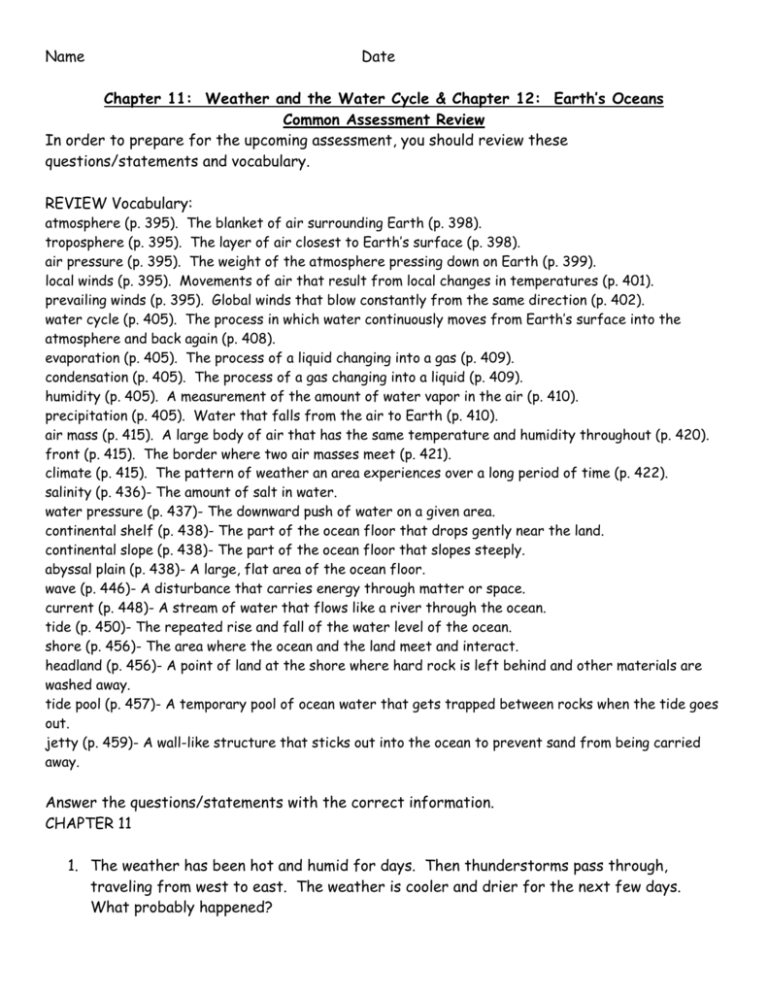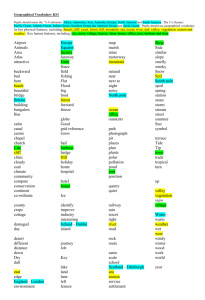Name Date Chapter 11: Weather and the Water Cycle & Chapter 12
advertisement

Name Date Chapter 11: Weather and the Water Cycle & Chapter 12: Earth’s Oceans Common Assessment Review In order to prepare for the upcoming assessment, you should review these questions/statements and vocabulary. REVIEW Vocabulary: atmosphere (p. 395). The blanket of air surrounding Earth (p. 398). troposphere (p. 395). The layer of air closest to Earth’s surface (p. 398). air pressure (p. 395). The weight of the atmosphere pressing down on Earth (p. 399). local winds (p. 395). Movements of air that result from local changes in temperatures (p. 401). prevailing winds (p. 395). Global winds that blow constantly from the same direction (p. 402). water cycle (p. 405). The process in which water continuously moves from Earth’s surface into the atmosphere and back again (p. 408). evaporation (p. 405). The process of a liquid changing into a gas (p. 409). condensation (p. 405). The process of a gas changing into a liquid (p. 409). humidity (p. 405). A measurement of the amount of water vapor in the air (p. 410). precipitation (p. 405). Water that falls from the air to Earth (p. 410). air mass (p. 415). A large body of air that has the same temperature and humidity throughout (p. 420). front (p. 415). The border where two air masses meet (p. 421). climate (p. 415). The pattern of weather an area experiences over a long period of time (p. 422). salinity (p. 436)- The amount of salt in water. water pressure (p. 437)- The downward push of water on a given area. continental shelf (p. 438)- The part of the ocean floor that drops gently near the land. continental slope (p. 438)- The part of the ocean floor that slopes steeply. abyssal plain (p. 438)- A large, flat area of the ocean floor. wave (p. 446)- A disturbance that carries energy through matter or space. current (p. 448)- A stream of water that flows like a river through the ocean. tide (p. 450)- The repeated rise and fall of the water level of the ocean. shore (p. 456)- The area where the ocean and the land meet and interact. headland (p. 456)- A point of land at the shore where hard rock is left behind and other materials are washed away. tide pool (p. 457)- A temporary pool of ocean water that gets trapped between rocks when the tide goes out. jetty (p. 459)- A wall-like structure that sticks out into the ocean to prevent sand from being carried away. Answer the questions/statements with the correct information. CHAPTER 11 1. The weather has been hot and humid for days. Then thunderstorms pass through, traveling from west to east. The weather is cooler and drier for the next few days. What probably happened? 2. What is the main difference between weather and climate? 3. Taylor is staying at a hotel at the beach. The weather is sunny and warm. He rushes outdoors to fly a kite at 6:00 A.M., but there is no wind. By 10:00 A.M, a good breeze is blowing. What happened between 6:00 A.M. and 10:00 A.M.? 4. What is the main cause of wind? 5. How can rising air pressure lead to a prediction about temperature? 6. The process that occurs when water that is heated by the sun becomes water vapor: 7. The weight of the atmosphere pressing down on Earth: 8. Name the instrument that measures air pressure: 9. You heat an ice cube, and it melts. Describe what will happen to the water if you continue to apply heat. 10. Suppose you’re going on vacation. The weather forecast says that a continental polar air mass will be over the region when you arrive. However, this air mass will be quickly replaced by a maritime tropical air mass. What kind of weather do you expect when you arrive on vacation? 11. A wind that results from local changes in temperature: 12. Which statement about Earth’s atmosphere is true? a. Most weather occurs in the highest of the four layers. b. The atmosphere is a very thick layer surrounding Earth. c. Most gases in the atmosphere are in the layer closest to Earth. d. The higher in the atmosphere you go, the higher the air pressure. 13. Which is a measure of the relative amount of moisture in the air? a. Humidity c. Temperature b. Oxygen level d. Wind speed 14. Which is not a factor that affects the climate in a particular area? a. Ozone in the stratosphere b. Distance from Earth’s poles c. Shape of the local landforms d. Distance from a body of water 15. Which pattern is generally true? a. As temperature increases, humidity decreases. b. As temperature decreases, air pressure increases. c. As air pressure increases, precipitation increases. d. As air pressure decreases, temperature increases. CHAPTER 12 16. What causes tides? 17. Which feature would you find at a sandy shore? 18. What would be about the same at the ocean’s surface and 1000 meters below the surface? 19. What is the measure of salt in water called? 20. What causes the weather pattern known as El Niño? 21. Describe the largest current: 22. A sharp point of rock that extends from the coast: 23. An area in which ocean water collects during low tide: 24. The rise and fall on the ocean level: 25. Your friends has drawn a picture that shows a scuba diver waving to a person inside the submersible Alvin, which is resting on the bare, flat abyssal plain. What is wrong with your friend’s picture? a. The abyssal plain is hilly, not flat. b. There should be seaweed growing on the ocean floor. c. The diver would be crushed by water pressure at that depth. d. The submersible cannot travel to the ocean floor. 26. Which statement is true? a. Waves carry water across the ocean. b. Waves break only during a storm surge. c. Waves carry the energy through the ocean. d. Waves are caused by tides pulling water onto the shore. 27. On the beach, you find a clipboard that someone left behind. The clipboard contains this page of notes. Sandy Beach Project Plan * Build jetty to stop longshore current. * Dredge sand from channel. * Dump dredged sand on beach. * Consider an artificial reef. What kind of project is the clipboard’s owner working on? a. restoring a beach b. mapping currents c. rescuing sea creatures d. exploring hydrothermal vents 28. Why are there high tides and low tides each day? a. Earth rotates on its axis once a day. b. Earth revolves around the sun each day. c. The moon revolves around Earth each day. d. Earth tilts toward the moon each day. Critical Thinking: Be prepared to answer open-ended questions in paragraph form. The following questions are suggested open-ended questions to help you prepare for this assessment. Please answer the following questions in complete sentences on a separate piece of paper, and attach. 1. Explain how weather can be measured and predicted? 2. Describe how light, temperature, and water pressure change/are different on parts of the ocean floor. 3. Suppose you’re going fishing on a lake. What type of winds might occur along the lakeshore? 4. Suppose factories were permitted to blow hot, toxic gases high up in the atmosphere. How would that impact the water cycle of the region? 5. Weather forecasters cannot predict the weather very far in advance. What are some of the factors that explain why long-term forecasts are not accurate? 6. What might happen to a hollow rubber ball if a submersible took it 300 m (1000 ft) below the ocean surface? Explain. 7. Scientists study satellite images that show the temperatures of different areas of the Pacific Ocean. Why is this information important? 8. How do fronts affect weather changes? 9. Surfers often watch weather forecasts for the open ocean hundreds or even thousands of miles away from their favorite beach. A big wind storm far out at sea is exciting news for surfers, especially if the storm does not reach land. Why would surfers be interested in storms that do not even reach their beach?








